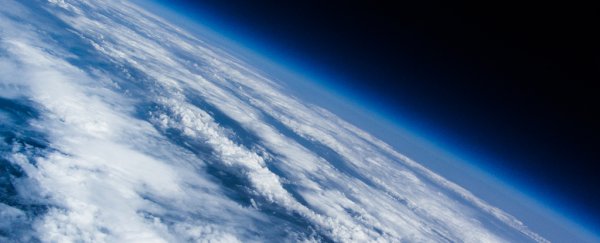Today, around 21 percent of Earth's atmosphere is made up of oxygen.
But our planet's atmosphere took time to develop to its current breathable state. The earliest mix of gases to form a thick layer around our cooling planet some 4.6 billion years ago wasn't much different to the kind of stuff emitted by volcanoes, such as methane, hydrogen sulfide, and carbon dioxide.
These were violent times – not only were Earth's guts churning with volatile materials, a steady bombardment of cold rocks from the inner Solar System delivered a constant supply of fresh material. Larger collisions occasionally reheated the surface, boiling off any collected moisture and ensuring the atmosphere remained a hot mess.
Yet that steady stream of minerals raining down from the sky also provided plenty of nitrogen in the form of ammonia.
When did oxygen appear in Earth's atmosphere?
There's plenty we still don't know about the details. Just how much nitrogen that early mineral rain provided our planet, for example, we're not entirely sure. But some time around 4.3 billion years ago Earth's hellish conditions finally started to cool and the deluge of space rocks eased up.
Bodies of water pooled long enough for various geochemical reactions – and possibly precursors to biochemistry – to take place, leaving the planet with a thickening atmosphere made up mostly of carbon dioxide and nitrogen.
There were possibly occasional 'whiffs' of oxygen puffing up from volcanic activity, here and there. But it didn't take long for it to react, leaving the planet largely oxygen free for its first billion years or so.
What was the Great Oxidation Event?
Earth's earliest attempts at biology would have needed to take the energy holding together one set of molecules and repurpose it to build organic materials. At some point early in the game, perhaps within hundreds of millions of years of Earth's formation, a mechanism for pulling energy provided by sunlight from certain chemicals was chanced upon.
Though it was technically photosynthesis, it wasn't the kind that left an excess of oxygen.
That 'oxygenic' variety of photosynthesis, it seems, could have originated as far back as 3 billion years ago, if not earlier. The biological machinery, called photosystem II, gave primitive microbes a boost, allowing them to recombine carbon dioxide and water to form the building blocks they needed, along with a generous charge of energy.
In spite of hundreds of millions of years of oxygen burps bubbling through the planet's oceans, there was minimal change to the atmosphere. One possible explanation for this surprising absence of oxygen is the ongoing drizzle of meteorites sliding through the skies, leaving volatile gases that readily reacted with the smallest traces of molecular oxygen.
Whatever the reason for the slow build up, around 2.4 billion years ago the trickle of oxygen gas finally amassed into significant levels, leading to what's become known as the Great Oxidation Event.
Was oxygen a good thing for life on Earth?
Just what kind of impact the sudden glut of oxygen gas had on Earth's biosphere is surprisingly hard to say.
Theoretically, oxygen is a pretty reactive element. Even today, we have specialized enzymes for dealing with the damage free oxygen can cause our more delicate organic molecules, such as DNA. So it's easy to imagine that without adaptations for coping with oxygen, early organisms would die off in huge numbers.
It's entirely possible a catastrophic die-off did in fact occur. Studies of isotopes locked up in 2 billion-year-old minerals suggest oxygen concentrations dipped as carbon was locked up in the tiny bodies of countless suffering microbes. Interpreting this ancient record isn't exactly straightforward, though; other studies question the assumptions, suggesting the drop in oxygen might not be due to any huge loss of life.
By around 600 million years ago, concentrations of molecular oxygen in our atmosphere finally reached around 21 percent.
This period of history happens to coincide with the emergence of complexity of living things. To what extent oxygen played a role – as opposed to a massive sprinkling of nutrients released from a global covering of glaciers scratching away at the surface – is hard to say.
On the one hand, oxygen is today an indispensable means of freeing up a large supply of energy from hydrocarbons. The perfect fuel for the modern multicellular organism on the go!
On the other, the precise order of oxygenation and the first complex organisms is debatable, making the relationship a somewhat complicated one.
Will Earth ever lose its oxygen?
So long as the Sun is shining, plants are blooming, and photosynthesis is pumping, it seems like our planet will always have a fairly decent amount of oxygen in its atmosphere. But that balance is not permanent.
In around a billion years, solar radiation will be strong enough to rip apart carbon dioxide. Without the gas, photosynthesis will grind to a standstill, and oxygen will fall to levels not seen since those very early days billions of years ago.
All Explainers are determined by fact checkers to be correct and relevant at the time of publishing. Text and images may be altered, removed, or added to as an editorial decision to keep information current.
